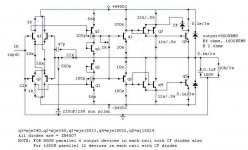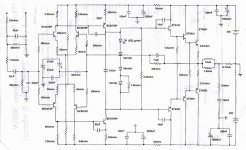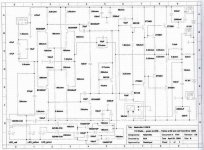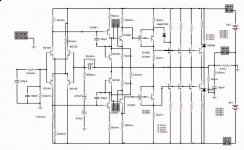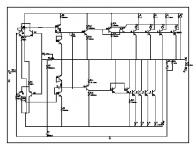You probably want to consider which companies you might
consider buying from and then check what they have. There
are zillions of transistors that are very difficult for most people
to get their hands on without a big company behind you.
consider buying from and then check what they have. There
are zillions of transistors that are very difficult for most people
to get their hands on without a big company behind you.
I'm looking for a list so I can look up what type of transistors I can use in a big amp I can only buy mj15003's here and I need to know what else I can use out of other equipment and surplus sales.eg I found the caps in an old motor starter 640uf 340v x80
I have a lot, but never used, no need off.
I have some information:
Motorola Trs 300K
Power Units 320K
Zetec Trs 125K
Fairchild units 700K
Sanken...too big, more than 3M
Toshiba catalogue 1M
But never used, if you want some i can send it to you... they are all in internet. but not so easy to find them.
I do not know you an expert of beginner... this way i will tell you as a beginner.
Buy those units:
Low power to differencial input audio:
BC547/557
BC546/556
BC639/640
Second stage:
BD139/140 or MJE340/350 (can do the same work)
Small power output and hy power driver units:
TIP41/42 (for output 30 Watts RMS) or good driver.
For Good output amplifiers:
TIP35/36 (not sure, but around 80 watts amps)
When 100 Watts darlington is needed:
TIP142/147
Driver to use when needed hi quality:
Mj15030/Mj15031
When hi power is needed:
MJ15003/15004 (check it)
When monster amplifier will be constructed:
Some pair or ,
2SC2922/2SA1216
This way, if you have those, you construct everything in audio amplifiers.... of course, can use many others, preferences, price, how difficult to find one and other...but you may have your own list, and type models in internet to have PDF data sheet for those units you will really use.
Transistors is always the same, and always different, it depends on size, voltage, current, frequency and gain.... respecting that needs no one will explode.
Some people say this sound better than those.... i could not perceive those small differences.... i am old, maybe no hearing so good. (not ironic, just a conclusion)
Carlos
I have some information:
Motorola Trs 300K
Power Units 320K
Zetec Trs 125K
Fairchild units 700K
Sanken...too big, more than 3M
Toshiba catalogue 1M
But never used, if you want some i can send it to you... they are all in internet. but not so easy to find them.
I do not know you an expert of beginner... this way i will tell you as a beginner.
Buy those units:
Low power to differencial input audio:
BC547/557
BC546/556
BC639/640
Second stage:
BD139/140 or MJE340/350 (can do the same work)
Small power output and hy power driver units:
TIP41/42 (for output 30 Watts RMS) or good driver.
For Good output amplifiers:
TIP35/36 (not sure, but around 80 watts amps)
When 100 Watts darlington is needed:
TIP142/147
Driver to use when needed hi quality:
Mj15030/Mj15031
When hi power is needed:
MJ15003/15004 (check it)
When monster amplifier will be constructed:
Some pair or ,
2SC2922/2SA1216
This way, if you have those, you construct everything in audio amplifiers.... of course, can use many others, preferences, price, how difficult to find one and other...but you may have your own list, and type models in internet to have PDF data sheet for those units you will really use.
Transistors is always the same, and always different, it depends on size, voltage, current, frequency and gain.... respecting that needs no one will explode.
Some people say this sound better than those.... i could not perceive those small differences.... i am old, maybe no hearing so good. (not ironic, just a conclusion)
Carlos
wonder_b said:I'm looking for a list so I can look up what type of transistors I can use in a big amp I can only buy mj15003's here and I need to know what else I can use out of other equipment and surplus sales.eg I found the caps in an old motor starter 640uf 340v x80
Wonder_b,
It looks like you're in NZ, so you might find the following useful.:
Retail Stores - a limited selection of transistors
Jaycar Electronics - Jaycar
Dick Smith - DSE
Both of these also do mail order.
Electronics Suppliers - a much better selection
RS Electronics - RS
Farnell Electronics - Farnell
Hope this helps,
SteveM
yes I am a beginner. yes I would like to get some of your catalogue files off you destroyer X my large file emal is wonder_b@slingshot.co.nz (20mb)
I am looking to build amp man's 800w 94vrails amp as a 600 (8ohm) 1150w(4ohm) 115vrails amp using around 8 output devices each rail incl cf diode and resistors .do you think this amp will work ok .
I am most likely going to get a box of 100 mj15024's from the us if I cant find anything else they are around $5 each nz landed I have found them here thank you for the links black dog. but they want around $17 + post each for them (to much!!!!!!) If you are in nz and looking for some mj150024's email me.
I am going to use 8x 12" 8ohm drivers per side on this amp $59 each from surplustrunics (.co.nz)in auckland I have 4 x10" now and they pump.
Also can anyone help I have a 200w x3 ( dick smith eti480 tweeked) it runs fine on the comp but when i plug it into the tv(panasonic 21") it makes a very loud buzz (50-100hz) whats up can you tell me
I am looking to build amp man's 800w 94vrails amp as a 600 (8ohm) 1150w(4ohm) 115vrails amp using around 8 output devices each rail incl cf diode and resistors .do you think this amp will work ok .
I am most likely going to get a box of 100 mj15024's from the us if I cant find anything else they are around $5 each nz landed I have found them here thank you for the links black dog. but they want around $17 + post each for them (to much!!!!!!) If you are in nz and looking for some mj150024's email me.
I am going to use 8x 12" 8ohm drivers per side on this amp $59 each from surplustrunics (.co.nz)in auckland I have 4 x10" now and they pump.
Also can anyone help I have a 200w x3 ( dick smith eti480 tweeked) it runs fine on the comp but when i plug it into the tv(panasonic 21") it makes a very loud buzz (50-100hz) whats up can you tell me
Attachments
Hellô Wonder B
My "turtle" telephone line system runs at 3.7 Kilobauds per second, and i can send those catalogues slowly to you... one each day. I will do it.
Will start in a matter of 15 hours... every 24 hours period at same time till finish.
No problems, i will do it happy!
Cannot say if your amplifier will run with good sound.
But i will simulate it in Multisim, but those simulators do everything, but cannot say if sounds good or not.
All assembly i done, with the same transistors showed in schematics, or also with different ones, i had always to change a little something... sometimes bias is hard to adjust... sometimes one of the transistors shows low VBE, something around 498 mV, and sometimes appear someone with to high VBE, around 689mV and i start to change some resistor value here or there.
Also i always increase input Condenser value, always i reduce coil output value, always i increase all line filter condenser and put 100n capacitor in parallel with those condensers, because condenser internal construction is alike a coil, so, have inductance too.... a parallel 100n capacitor will let oscilations, or RF picked on wires flow direct and easy into earth ground.
As i construct and test at least 12 amplifiers each month, and in those 40 years i could find only two that i really like the sound, i am very skilled related how to control frustration and not to destroy 30 percent of the assembling because work bad or measure bad or sound bad.... amplifiers can measure good and sound awfull, also can measure bad and sounds good, complicated ones normally sounds bad, simple ones normally sounds better... each component distorts a little bit, so, better to have one transistor (impossible in pratical life) doing whole job.
Finishing assembling and connect and work since first time happens really, not more than 10 percent of the ones i have done... i made some thousands of amplifiers in my life.... 60 percent i could hear, 30 percent are completely awfull, and 10 percent can be usefull.
Wonder, if you think a little you will see that i do not like "normal" sound... i prefer some special kind of harmonic distortion that looks more natural to me.
My idea, best wide world amplifier, no doubts, Death of Zen, from Mr. Rodd Elliot, ESP, in Australia.... others.... i am sorry.
I never keep amplifiers assembled...no place enougth and when doing for testing i do not matter if pretty or not.... must work with good sound... that's some brazilian people are.... people do not need to be pretty, and also do not need to be rich, do not need to be clever, have to be kind, have to be friendly and stay together us alike a dog does... this way, pretty amplifiers do not tell me nothing more than a good looking pleasure that stays in my heart for seconds..... good sound will make you dream for ever.
Sometimes i use transistors that i obtain in 1970... normally i do not buy in shops.... i use to dismount Japanese old models that we bougth here for 10 dollares or less than that.... full of power transistors an whole filters and transformers.... very difficult to go out to buy some...only boards and solder.
I will put an amplifier that is very strong and you can assemble without afraid... this one i can guarantee.... others not. This one sounds good, but loose power in deep bass.... but is so strong that you can reduce treble and put it to shake your neighborhood.
Carlos
My "turtle" telephone line system runs at 3.7 Kilobauds per second, and i can send those catalogues slowly to you... one each day. I will do it.
Will start in a matter of 15 hours... every 24 hours period at same time till finish.
No problems, i will do it happy!
Cannot say if your amplifier will run with good sound.
But i will simulate it in Multisim, but those simulators do everything, but cannot say if sounds good or not.
All assembly i done, with the same transistors showed in schematics, or also with different ones, i had always to change a little something... sometimes bias is hard to adjust... sometimes one of the transistors shows low VBE, something around 498 mV, and sometimes appear someone with to high VBE, around 689mV and i start to change some resistor value here or there.
Also i always increase input Condenser value, always i reduce coil output value, always i increase all line filter condenser and put 100n capacitor in parallel with those condensers, because condenser internal construction is alike a coil, so, have inductance too.... a parallel 100n capacitor will let oscilations, or RF picked on wires flow direct and easy into earth ground.
As i construct and test at least 12 amplifiers each month, and in those 40 years i could find only two that i really like the sound, i am very skilled related how to control frustration and not to destroy 30 percent of the assembling because work bad or measure bad or sound bad.... amplifiers can measure good and sound awfull, also can measure bad and sounds good, complicated ones normally sounds bad, simple ones normally sounds better... each component distorts a little bit, so, better to have one transistor (impossible in pratical life) doing whole job.
Finishing assembling and connect and work since first time happens really, not more than 10 percent of the ones i have done... i made some thousands of amplifiers in my life.... 60 percent i could hear, 30 percent are completely awfull, and 10 percent can be usefull.
Wonder, if you think a little you will see that i do not like "normal" sound... i prefer some special kind of harmonic distortion that looks more natural to me.
My idea, best wide world amplifier, no doubts, Death of Zen, from Mr. Rodd Elliot, ESP, in Australia.... others.... i am sorry.
I never keep amplifiers assembled...no place enougth and when doing for testing i do not matter if pretty or not.... must work with good sound... that's some brazilian people are.... people do not need to be pretty, and also do not need to be rich, do not need to be clever, have to be kind, have to be friendly and stay together us alike a dog does... this way, pretty amplifiers do not tell me nothing more than a good looking pleasure that stays in my heart for seconds..... good sound will make you dream for ever.
Sometimes i use transistors that i obtain in 1970... normally i do not buy in shops.... i use to dismount Japanese old models that we bougth here for 10 dollares or less than that.... full of power transistors an whole filters and transformers.... very difficult to go out to buy some...only boards and solder.
I will put an amplifier that is very strong and you can assemble without afraid... this one i can guarantee.... others not. This one sounds good, but loose power in deep bass.... but is so strong that you can reduce treble and put it to shake your neighborhood.
Carlos
This is the Nashville power amplifier
A Brazilian factory already closed.... this is the lower powered from all them.
Can increase voltage to 70 volts plus and minus.... and use TIP41/TIP42 in the output, you will find three units in darlington conection, emitter to base and colectors together..... first and second may be those TIPs.... or the MJ all the people likes to put in their schematics.. do not use BD139/140 because voltage is too high, also do not use their cousin MJE340/350 too.
All others transistors must be something alike BC546/556, look into their maximum VCE (Volts from colector to emitter) if can be usefull.... better when they are twice the voltage used in plus, or twice the voltage used in minus rails.
In the output use your power MJ transistor.... if they are the ones for output power.... the ones that can work with more than 10 amperes and voltage more than 150 volts. Put 4 pairs and enormous heat sink and take the bigger transformer you can find... one transformer for each channell, also, at least, minimum 20000 uF each voltage rail electrolitic condensers for filtering.... if more will be better.... big bridge rectifier units, one for each transformer and prepare yourself to receive a punch of bass in your stomach.
Carlos
A Brazilian factory already closed.... this is the lower powered from all them.
Can increase voltage to 70 volts plus and minus.... and use TIP41/TIP42 in the output, you will find three units in darlington conection, emitter to base and colectors together..... first and second may be those TIPs.... or the MJ all the people likes to put in their schematics.. do not use BD139/140 because voltage is too high, also do not use their cousin MJE340/350 too.
All others transistors must be something alike BC546/556, look into their maximum VCE (Volts from colector to emitter) if can be usefull.... better when they are twice the voltage used in plus, or twice the voltage used in minus rails.
In the output use your power MJ transistor.... if they are the ones for output power.... the ones that can work with more than 10 amperes and voltage more than 150 volts. Put 4 pairs and enormous heat sink and take the bigger transformer you can find... one transformer for each channell, also, at least, minimum 20000 uF each voltage rail electrolitic condensers for filtering.... if more will be better.... big bridge rectifier units, one for each transformer and prepare yourself to receive a punch of bass in your stomach.
Carlos
Attachments
Change green led for two normal diodes
Not only change this green led for two normal diodes (1N4007) but glue all them (diodes) in your heat sink to receive heat and control the amplifier temperature.
Also substitute the 1K paralleled resistor you see together one of those bias diodes for a trimpot to adjust bias current without signal in the input..... calculate and measure each rail emitter transistors... you will have four transistor positive side, with 0.33 ohms resistors and more 4 transistors negative side with 0.33 ohms wire resistor (5 watts each one)....measure DC voltage over each one of those resistors and adjust bias to have from 20 to 40 milivolts DC on each of them.
Better to not use insulators.... use silicon grease and attached them directly to heatsinks.... the heatsinks will have to be electrical isolated one related to the other, because this way you will have plus 70 in one of them and minus 70 in the other one... isolate with wood one related to the other and isolate all two heatsinks from metal chassis with wood material or another good electrical insulator..... 140 volts can be real dangerous, this way think about it with care, maybe you have to cover heatsinks attached at the bottom of you enclosure and help them with two fans with only 8.5 volts DC each one to not make big noise (normal is 12 volts)...use small transformer to power your fans.
Insulators are bad... real bad!.... you touch transistor and feel them overheated... and touch heatsink and fell them with less temperature.... so.... do not transfer heat in the best way.
Some overcharge can melt transistor before heatsink became real hot... this way is suicide!
Carlos
Not only change this green led for two normal diodes (1N4007) but glue all them (diodes) in your heat sink to receive heat and control the amplifier temperature.
Also substitute the 1K paralleled resistor you see together one of those bias diodes for a trimpot to adjust bias current without signal in the input..... calculate and measure each rail emitter transistors... you will have four transistor positive side, with 0.33 ohms resistors and more 4 transistors negative side with 0.33 ohms wire resistor (5 watts each one)....measure DC voltage over each one of those resistors and adjust bias to have from 20 to 40 milivolts DC on each of them.
Better to not use insulators.... use silicon grease and attached them directly to heatsinks.... the heatsinks will have to be electrical isolated one related to the other, because this way you will have plus 70 in one of them and minus 70 in the other one... isolate with wood one related to the other and isolate all two heatsinks from metal chassis with wood material or another good electrical insulator..... 140 volts can be real dangerous, this way think about it with care, maybe you have to cover heatsinks attached at the bottom of you enclosure and help them with two fans with only 8.5 volts DC each one to not make big noise (normal is 12 volts)...use small transformer to power your fans.
Insulators are bad... real bad!.... you touch transistor and feel them overheated... and touch heatsink and fell them with less temperature.... so.... do not transfer heat in the best way.
Some overcharge can melt transistor before heatsink became real hot... this way is suicide!
Carlos
Here another Nashville with some mods.
Sorry, image awfull, but sounds good!
And if you want to broke glasses, it will be good, it is already used in big trucks, with more than 50 speaker boxes, each one with 15 inches speaker, exponential front, and tuned with ports... wooden boxes, 2 inches large wooden panels... cloth and other damping material inside, mounted on rubber and protected with metal fences.
Inside this enormous trucks, Scania Vabis 22 whelled trucks, very long an very tall units, with people dancing and whole orchestra, and mixers, and microfones, electronic drums and normal drums.
Generators running inside, air conditioned.... 10 Kw total power used 30 percent volume.... and those Nashville and also other Brazilian brand called Cygnus making whole work.... a lot of mid range drivers and also hi frequency drivers... electronic crossovers separate frequencies and goes to some amplifiers, and them to speakers, without coils or condenser in the speakers enclosures... the whole thing is made not to confuse speakers or amplifiers...each one make a small part of the whole job.
4 Kilometers ahead and you feel the bass punch shaking appartment glasses, mine is 16th floor.
If not so good, it is the one i trust.... if not so powerfull, make two of them.
I will simulate your and i will tell you some...but cannot trust entirely in simulation... it give you an idea...but not so precise, and cannot say if sounds good to your ears or not... depends on you!
Carlos
Sorry, image awfull, but sounds good!
And if you want to broke glasses, it will be good, it is already used in big trucks, with more than 50 speaker boxes, each one with 15 inches speaker, exponential front, and tuned with ports... wooden boxes, 2 inches large wooden panels... cloth and other damping material inside, mounted on rubber and protected with metal fences.
Inside this enormous trucks, Scania Vabis 22 whelled trucks, very long an very tall units, with people dancing and whole orchestra, and mixers, and microfones, electronic drums and normal drums.
Generators running inside, air conditioned.... 10 Kw total power used 30 percent volume.... and those Nashville and also other Brazilian brand called Cygnus making whole work.... a lot of mid range drivers and also hi frequency drivers... electronic crossovers separate frequencies and goes to some amplifiers, and them to speakers, without coils or condenser in the speakers enclosures... the whole thing is made not to confuse speakers or amplifiers...each one make a small part of the whole job.
4 Kilometers ahead and you feel the bass punch shaking appartment glasses, mine is 16th floor.
If not so good, it is the one i trust.... if not so powerfull, make two of them.
I will simulate your and i will tell you some...but cannot trust entirely in simulation... it give you an idea...but not so precise, and cannot say if sounds good to your ears or not... depends on you!
Carlos
Attachments
Wonder, i am having troubles to simulate
And i will need to spent some time, with pleasure, to try to make it work someway.
Problem with bias.
But this is the begining, not the end.
One reality, is something that i have learned doing; if some circuit simulates bad, or very bad; in real world, it can work bad, or work good....but;
One circuit that do not simulates, never worked in real world.
I will need sometime, maybe one day or more, be patient.
Carlos
And i will need to spent some time, with pleasure, to try to make it work someway.
Problem with bias.
But this is the begining, not the end.
One reality, is something that i have learned doing; if some circuit simulates bad, or very bad; in real world, it can work bad, or work good....but;
One circuit that do not simulates, never worked in real world.
I will need sometime, maybe one day or more, be patient.
Carlos
Attachments
"is there anywhere I can get a list of all the transistors avalble and there specs"
There probably is no such comprehensive list, The are thick catlogs full of cross references but which cost quite a bit. What you might try is an file (.xls format I think) on the ESP website sound.au.com. I don't remember just which page it is on -- try "downloads".
There probably is no such comprehensive list, The are thick catlogs full of cross references but which cost quite a bit. What you might try is an file (.xls format I think) on the ESP website sound.au.com. I don't remember just which page it is on -- try "downloads".
If last amp is the same one as I put on there (amp mans amp) you need a cf diode on each + side transistor not just one and I added the resistor for every output transistor he sead only one per side for all I think thats a ******* up .I was thinking of running 8 output transistors per side and 115v rails (600 8ohm 1200 4ohm 2 boxes per side 4 x 12" drivers 4 pezo tweeters each box)
You can build almost anything that you need....audio-wise......with about a dozen transistors from Toshiba.
I ignore everything else.
Except for RF designs.
OK, there are few decent ones that Zetex makes that I would use in a pinch.
Jocko
I ignore everything else.
Except for RF designs.
OK, there are few decent ones that Zetex makes that I would use in a pinch.
Jocko
thanks for the files destroyerX they are a lot of help I have found some power transistors now .
when you did the simulation did you have the outputs the same as this with 4 mj15024 or simlar on each side with cf diodes and 8ohm load with 115v rails and also can the amp simulation programs be found on the net for download
when you did the simulation did you have the outputs the same as this with 4 mj15024 or simlar on each side with cf diodes and 8ohm load with 115v rails and also can the amp simulation programs be found on the net for download
Attachments
Womder, your attachment is saved
I do not take a look at it yet!...but i will.
A lot of people says that simulation is no good.... and they are not common people, are very good expertise and skilled enginneers, also they say that simulation do not can tell us "how it sounds!".... so, do not take the things i told you as a God words!... probable you will have problems... i could not simulate...voltages are all crazy.... i change a lot, also voltages reduction, and diodes and a lot of things but no way.... spending more than 2 ours i decided to stop and decided also think the circuit is problematic.
But do not believe too much in this info.... the ones that simulates good sometimes works bad or works good....but never the one that do not works in simulation worked in real world.... thas the experience 2 years using simulation before assembling.
regards
Carlos
I do not take a look at it yet!...but i will.
A lot of people says that simulation is no good.... and they are not common people, are very good expertise and skilled enginneers, also they say that simulation do not can tell us "how it sounds!".... so, do not take the things i told you as a God words!... probable you will have problems... i could not simulate...voltages are all crazy.... i change a lot, also voltages reduction, and diodes and a lot of things but no way.... spending more than 2 ours i decided to stop and decided also think the circuit is problematic.
But do not believe too much in this info.... the ones that simulates good sometimes works bad or works good....but never the one that do not works in simulation worked in real world.... thas the experience 2 years using simulation before assembling.
regards
Carlos
is there anywhere on the net that I can fine amp simulation software to download .I would like to have a play with something like that
LINEAR TECHNOLOGY SPICE
wonder_b,
Linear Technology offers an excellent free SPICE with schematic capture. You can find hundreds of device SPICE models at vendor sites, and from a good web search. There is also a SPICE model thread here on diyAudio.com
www.linear.com/software/
wonder_b,
Linear Technology offers an excellent free SPICE with schematic capture. You can find hundreds of device SPICE models at vendor sites, and from a good web search. There is also a SPICE model thread here on diyAudio.com
www.linear.com/software/
- Status
- Not open for further replies.
- Home
- Amplifiers
- Solid State
- list of transistors
